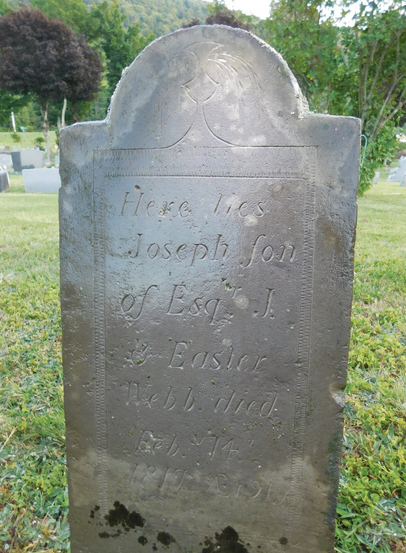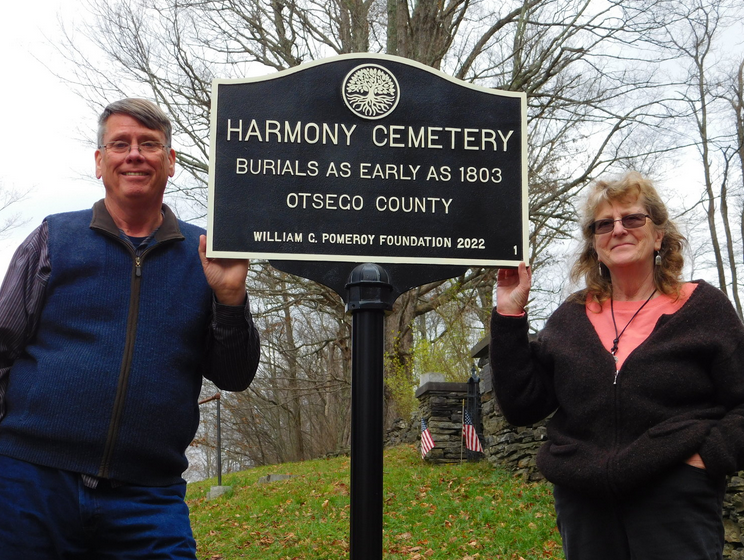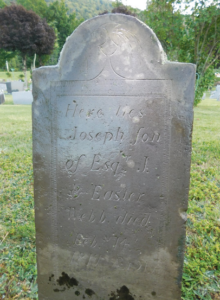Our Maine Adventure
We have talked about a vacation in Arizona for years. Our reservations were made when the pandemic hit the country. Like many others, our plans were canceled. We will try again another time.
We had no thoughts on going anywhere until Tina saw that Maine was calling for visitors. This would be a chance to use our book titled “Maine’s Coastal Cemeteries.”
On the way to Maine we stopped in Brattleboro, Vt. A gravestone carver named Stephen Risley once lived in Madison in the early 1800s. We had seen his work in both sandstone and marble but we knew he lived in Brattleboro prior to moving to New York, circa 1811, and we wondered if we could identify his work there. We were pleased to find his work in Vermont and discovered it was similar to our findings in New York. His basic motif was an urn in the tympanum (top of the gravestone) surrounded by a wreath or circle. The stones are simple but striking.
In New York cemeteries we see gravestones obviously done by different carvers. We often wonder, where did the carvers come from? Did they bring their carving skills with them? Did they mimic previous designs or did they expand their creative talents and come up with something new? This was an opportunity to answer some questions. In Risley’s case he continued his general theme from Vermont but with variations.
Our first stop in Maine was, of course, a cemetery. We found evidence of the evolution of gravestone iconography with all three phases represented: winged skulls, winged faces and finally, willows and urns, as found in our area. But our most exciting find was seeing the beautiful, rugged coast of Maine.
We decided to follow the coastline north. It was a hot summer day and with it we found throngs of people enjoying the water. Our travel time slowed considerably as we encountered traffic congestion and people crossing the road to get to the beach – not what we had in mind.
We stayed in a two-story cottage on a lake. We were on the second floor, a place aptly called “the tree house” because looking out the windows all you could see were trees.
The next day we were up early and headed for Quoddy Head State Park, the nation’s most eastern point. We had breakfast overlooking a beautiful lake and watched the sun rise as ducks played on the beach and in the water.
One interesting stop was a cemetery where we found slate gravestones with multi-colored veining – unusual but pretty. What we found most intriguing were the figures on some of the gravestones. We are used to seeing winged skulls or faces but here we saw examples of what looked like spiders with light-bulb like faces but their wings made them resemble more the legs of spiders.
As we drove along, we caught glimpses of the rocky coast, ships on the water, stacks of lobster traps or an occasional lighthouse. It was low tide so we stopped several times to walk the beach or take in a view of the coast and water. It was relaxing and calming to hear the waves washing up on the shore.
One place we passed got our immediate attention. It was called “BIG Chicken Barn – Books and Antiques.” Big is an understatement – it was a humongous three-story chicken coop, the largest we have ever seen. It would have taken hours to walk through its many antique booths. The number of books and magazines was amazing.
It was another hot, sunny day with temperatures reaching the low 90s. Nearing our destination, the temperature started to drop and by the time we arrived at the end of the peninsula of Quoddy Head State Park, we were surrounded by fog and the temperature had unbelievably dropped to 65 degrees.
The state park was a wonderful place. The red and white striped lighthouse there has stood since 1858 when the brick structure replaced the original stone one that had served since 1808 when commissioned by President Thomas Jefferson. In the distance we heard the constant sound of a whistle or groaner buoy which sounded like a foghorn to us.
The nearly five miles of trails were fabulous and wound through forest and wetlands and afforded views of the water from the bluffs along the tree-lined coast and gave us access to the rocky shore below. These waters of the Bay of Fundy are home to four species of whales providing an excellent area for viewing the majestic creatures. In addition, tides rise and fall an average of 15.8 feet in six hours. A side trail goes through a peat bog with great interpretive displays. Although shrouded in fog nearly 60 days a year, it is truly a special place and lives up to its name that means “fertile and beautiful place.”
Nearby was the historic fishing village of Lubec, established in 1811. We stopped in a cemetery there hoping to find some nautical themes and found a beautiful sailing ship carved into a marble headstone and numerous captain’s stones. The scenic waterfront still has remnants of the old fish processing buildings on the docks. It appears the quiet little town is being revitalized.
In the fields along the road we noticed a blue tint to the low-lying vegetation. We couldn’t figure out what it was so we stopped and found it we were seeing fields of ripe blueberries. Maine is the world’s largest producer of wild blueberries. At one point we had to stop for a convoy of blueberry harvesters. A drive by “Wild Blueberry Land” was an interesting sight with its blue buildings and giant blueberries scattered about. Too bad they were closed as I would have loved to try their blueberry sundae.
As we passed Columbia Falls, we saw the “Home of the National Office and Museum for Wreaths Across America,” the organization responsible for coordinating December wreath-laying ceremonies at Arlington National Cemetery and over 2100 additional locations – a worthy program.
In Gray, Maine, we found a gravestone: “Stranger – A soldier of the late war died 1862 – Erected by the ladies of Gray.” Apparently a mother received her son’s body home from the Civil War only to discover that the coffin contained the body of a Confederate soldier and not her son. What an emotional impact that must have had on the mother. However, the ladies of Gray adopted the soldier and provided a stone for him. To this day they care for the plot and provide a confederate flag to commemorate this lost veteran.
On the way home we stopped at cemeteries in New Hampshire and Vermont to view the gravestones done by Jonas Stuart Sr., the father of a carver noted in our area, J.W. Stewart, also known as Coffin Man. The elder carver had a 50-year career carving gravestones from about 1772 to 1823. His images ranged from an early pumpkin-head design to winged faces to the traditional willow and urn. Jonas was truly a master at his craft and we greatly enjoyed seeing his work in the cemeteries he traversed so many years ago. There are four Coffin Man stones in the Walton Cemetery that were relocated when the reservoirs were constructed. While looking for Stuart stones, we were surprised to find the distinctive work of a carver that we had only seen around Delaware County. In two cemeteries we found three stones with his unusual loop that extends from the last “d” in died to the capital “D” in died. In addition, one of his trademarks is a horizontal coffin which we saw on one of the three stones. This raised questions for us. Was our New York carver (we call him Fancy D), or his family from this area? When and why did he come to New York? We must go back to see if we can find more of his work.
These are just some of the noteworthy experiences we had. We hated to see our journey end but we look forward to sharing our next adventure.

Coffin Man stone – Walton Cemetery
September 2, 2020


